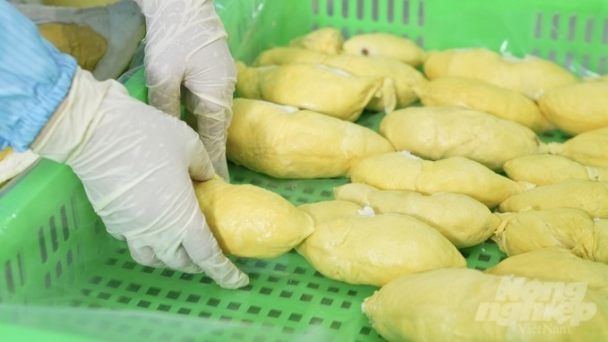January 7, 2025 | 12:14 GMT +7
January 7, 2025 | 12:14 GMT +7
Hotline: 0913.378.918
January 7, 2025 | 12:14 GMT +7
Hotline: 0913.378.918

Vietnam leads in exporting fish filets to Singapore.
Singapore is a major seafood import market in Southeast Asia. According to the Vietnam Trade Office in Singapore, statistics from the Singapore Business Authority show that in the first nine months of 2024, Singapore imported seafood from nearly 100 countries and territories, totaling SGD 839 million in value.
In the first quarter of 2024, Malaysia remains the largest seafood exporting country to the Singaporean market among the top 15, with Norway in second place, Indonesia in third, China in fourth, and Vietnam surpassing Japan for the first time to secure the fifth position as a significant seafood exporting partner to the Singaporean market.
In the first nine months of this year, Vietnamese seafood exports to Singapore reached over 77 million SGD, accounting for 9% of Singapore's total seafood imports. Vietnam follows Malaysia (13%), Indonesia (11%), Norway (10%), and China (10%) in market share.
In Singapore's seafood market, each of the six largest exporting countries (holding 9-13% market share) leads in different product groups.
According to the Vietnam Trade Office in Singapore, major seafood product groups in the Singapore market include: shrimp, crab, and crustaceans, making up 24% of total market consumption; followed by fresh and chilled fish at 19%; frozen fish at 19%; fish fillets, fresh or frozen fish meat at 17%; and mollusks at 10%. Other product groups like fresh fish, processed fish, and aquatic seafood have relatively low shares at 4%, 5%, and 3% respectively.
Vietnam dominates Singapore's seafood market in frozen fish fillets (30%) and processed fish (20%). Malaysia has a strength in fresh fish, shrimp, and crustaceans, with a market share of 31% and 20% in these segments respectively. Norway and Spain excel in fresh chilled and frozen fish, while China has an advantage in mollusk products (holding a 29% market share). Japan leads in aquatic seafood (holding a 40% market share).

Processing fish at a factory in the Mekong Delta. Photo: Son Trang.
According to Mr. Cao Xuan Thang, Commercial Counselor and Head of the Vietnam Trade Office in Singapore, the data highlights the important position and role of Vietnamese seafood in Singapore. Notably, by the end of third quarter of 2024, Vietnamese seafood has maintained its 5th position for three consecutive quarters in this market.
With a policy of diversifying supply sources, Singapore continuously seeks and expands its import markets through various policies, intensifying competition among seafood-exporting countries.
Thus, Mr. Thang suggested that to sustainably increase market share and improve export rankings and value, Vietnam's seafood sector must continue to enhance product quality.
Vietnam is facing rising inflation and tightened spending trends as they pose challenges for seafood exports to Singapore. Countries that capitalize on logistics advantages and minimize costs will gain a greater competitive edge in exporting to Singapore.
Also in order to improve seafood exports to Singapore and the world market as a whole, the Vietnam Trade Office in Singapore recommends that Vietnamese seafood companies do thorough research and make efficient use of the advantages provided by the Free Trade Agreements (FTAs) that Vietnam is a part of. Consistently, Vietnam needs to revise Singapore's rules, particularly those pertaining to quality standards, labeling requirements.
Engage actively in trade fairs and exhibits to boost brand marketing, product promotion, and expand the presence of Vietnamese products in the global market. This will promote competitiveness and ensure consistent product quality and reputation with foreign partners.
Mr. Thang also noted that to boost seafood exports to Singapore specifically, and the global market generally, the Trade Office is actively connecting with leading Vietnamese seafood companies to share information on products sought by Singaporean importers. They are also linking up with the Singapore Seafood Industries Association to support connections with Vietnamese companies and assisting them in participating in trade fairs to increase the presence of Vietnamese goods in the market.
Currently, Singapore is not among Vietnam's top 10 seafood markets, but it remains a market of interest. According to the Vietnam Association of Seafood Exporters and Producers (VASEP), Singapore has minimal technical barriers to seafood imports and possibly accept higher prices. Singapore is also renowned for its extensive network of restaurants, tourism, hospitality, and its multi-ethnic population, all of whom consume seafood.
Translated by Kieu Chi

(VAN) The high import volumes and differences in agricultural production of Sweden make it an appealing marketplace for Vietnamese fruits and vegetables.

(VAN) In Bangladesh, public opinion holds strong that frozen seafood is inferior to its fresh counterparts, however, as Zubair Khan explains, this is often not the case.

(VAN) India is planning to triple its wheat storage capacity over the next three years to 9 million tonnes, up from the current 2.8 million tonnes, according to a report from the Financial Express.

(VAN) Chinese businesses believe that Vietnamese agricultural products, especially durian, can establish a solid position in the billion-person market if meeting technical criteria.

(VAN) Vegetable and fruit exports experienced substantial growth in 2023 and continued to experience remarkable increases in 2024, with numerous turnover records being achieved.

(VAN) Top cocoa producers Ivory Coast and Ghana have suffered crop losses due to adverse weather, bean disease, smuggling and reduced plantations in favour of illegal gold mining.

(VAN) South American crop prospects are one thing the American markets are closely watching.